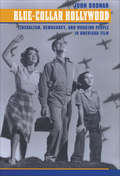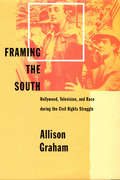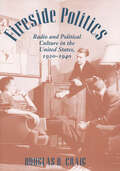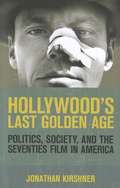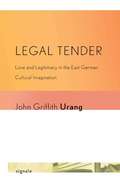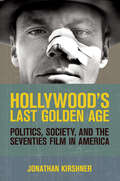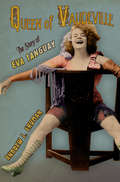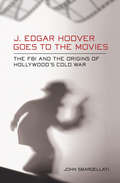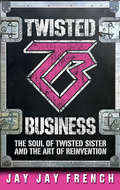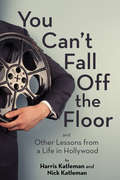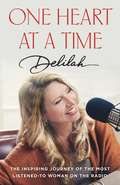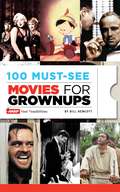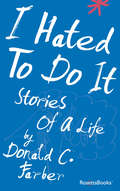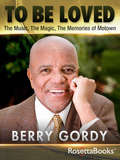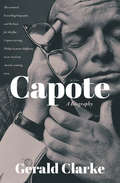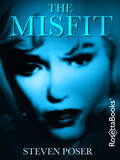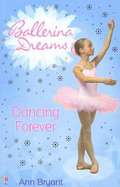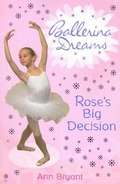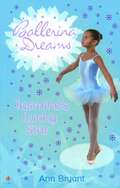- Table View
- List View
Blue-Collar Hollywood: Liberalism, Democracy, and Working People in American Film
by John BodnarSelected by Choice Magazine as an Outstanding Academic Title for 2003From Tom Joad to Norma Rae to Spike Lee's Mookie in Do the Right Thing, Hollywood has regularly dramatized the lives and struggles of working people in America. Ranging from idealistic to hopeless, from sympathetic to condescending, these portrayals confronted audiences with the vital economic, social, and political issues of their times while providing a diversion—sometimes entertaining, sometimes provocative—from the realities of their own lives.In Blue-Collar Hollywood, John Bodnar examines the ways in which popular American films made between the 1930s and the 1980s depicted working-class characters, comparing these cinematic representations with the aspirations of ordinary Americans and the promises made to them by the country's political elites. Based on close and imaginative viewings of dozens of films from every genre—among them Public Enemy, Black Fury, Baby Face, The Grapes of Wrath, It's a Wonderful Life, I Married a Communist, A Streetcar Named Desire, Peyton Place, Taxi Driver, Raging Bull, Coal Miner's Daughter, and Boyz N the Hood—this book explores such topics as the role of censorship, attitudes toward labor unions and worker militancy, racism, the place of women in the workforce and society, communism and the Hollywood blacklist, and faith in liberal democracy.Whether made during the Great Depression, World War II, the Cold War, or the Vietnam era, the majority of films about ordinary working Americans, Bodnar finds, avoided endorsing specific political programs, radical economic reform, or overtly reactionary positions. Instead, these movies were infused with the same current of liberalism and popular notion of democracy that flow through the American imagination.
Framing the South: Hollywood, Television, and Race during the Civil Rights Struggle
by Allison GrahamWhat patterns emerge in media coverage and character depiction of Southern men and women, blacks and whites, in the years between 1954 and 1976? How do portrayals of the region and the equal rights movement illuminate the spirit and experience of the South—and of the nation as a whole? In Framing the South, Allison Graham examines the ways in which the media, particularly television and film, presented Southerners during the period of the civil rights revolution.Graham analyzes depictions of southern race and social class in a wide range of Hollywood films—including A Streetcar Named Desire, The Three Faces of Eve, and A Face in the Crowd from the 1950s; later films like Cool Hand Luke, In the Heat of the Night, and Mississippi Burning; and MGM's Elvis Presley vehicles. She traces how films have confronted—or avoided—issues of racism over the years, paralleling Hollywood depictions with the tamer characterization of the likeable "hillbilly" popularized in television's The Real McCoys and The Andy Griffith Show. Graham reinforces the political impact of these fictional representations by examining media coverage of civil rights demonstrations, including the documentary Crisis: Behind the Presidential Commitment, which reported the clash between Robert Kennedy and Governor George Wallace over the integration of the University of Alabama. She concludes with a provocative analysis of Forrest Gump, identifying the popular film as a retelling of post-World War II Southern history.
Fireside Politics: Radio and Political Culture in the United States, 1920–1940 (Reconfiguring American Political History)
by Douglas B. CraigAn “impressively researched and useful study” of the golden age of radio and its role in American democracy (Journal of American History).In Fireside Politics, Douglas B. Craig provides the first detailed and complete examination of radio’s changing role in American political culture between 1920 and 1940—the medium’s golden age, when it commanded huge national audiences without competition from television.Craig follows the evolution of radio into a commercialized, networked, and regulated industry, and ultimately into an essential tool for winning political campaigns and shaping American identity in the interwar period. Finally, he draws thoughtful comparisons of the American experience of radio broadcasting and political culture with those of Australia, Britain, and Canada.“The best general study yet published on the development of radio broadcasting during this crucial period when key institutional and social patterns were established.” ?Technology and Culture
Fireside Politics: Radio and Political Culture in the United States, 1920-1940 (Reconfiguring American Political History)
by Douglas B. CraigIn Fireside Politics, Douglas B. Craig provides the first detailed and complete examination of radio's changing role in American political culture between 1920 and 1940—the medium's golden age, when it commanded huge national audiences without competition from television. Craig follows the evolution of radio into a commercialized, networked, and regulated industry, and ultimately into an essential tool for winning political campaigns and shaping American identity in the interwar period. Finally, he draws thoughtful comparisons of the American experience of radio broadcasting and political culture with those of Australia, Britain, and Canada.
Hollywood's Last Golden Age
by Jonathan KirshnerBetween 1967 and 1976 a number of extraordinary factors converged to produce an uncommonly adventurous era in the history of American film. The end of censorship, the decline of the studio system, economic changes in the industry, and demographic shifts among audiences, filmmakers, and critics created an unprecedented opportunity for a new type of Hollywood movie, one that Jonathan Kirshner identifies as the "seventies film." In Hollywood's Last Golden Age, Kirshner shows the ways in which key films from this period-including Chinatown, Five Easy Pieces, The Graduate, and Nashville, as well as underappreciated films such as The Friends of Eddie Coyle, Klute, and Night Moves-were important works of art in continuous dialogue with the political, social, personal, and philosophical issues of their times. These "seventies films" reflected the era's social and political upheavals: the civil rights movement, the domestic consequences of the Vietnam war, the sexual revolution, women's liberation, the end of the long postwar economic boom, the Shakespearean saga of the Nixon Administration and Watergate. Hollywood films, in this brief, exceptional moment, embraced a new aesthetic and a new approach to storytelling, creating self-consciously gritty, character-driven explorations of moral and narrative ambiguity. Although the rise of the blockbuster in the second half of the 1970s largely ended Hollywood's embrace of more challenging films, Kirshner argues that seventies filmmakers showed that it was possible to combine commercial entertainment with serious explorations of politics, society, and characters' interior lives.
Legal Tender
by John Griffith UrangTreating films including Leander Hauss/mann's controversial Sonnenalle (1999), Urang (visiting professor of German, Reed College, Portland, Oregon) explores the question of why in so many East German films and novels love trumps the crumbling political culture of the GDR. Citing Niklas Luhmann's Love as Passion: The Codification of Intimacy as a key influence, he examines how the "semantics of love" interact with socialist-realist processes of authoritarianism. While these love stories draw on the Western tradition, they also critique bourgeois romantic love institutions and practices--a metaphor for reunification with West Germany. Annotation ©2011 Book News, Inc. , Portland, OR (booknews. com)
Hollywood's Last Golden Age: Politics, Society, and the Seventies Film in America
by Jonathan KirshnerBetween 1967 and 1976 a number of extraordinary factors converged to produce an uncommonly adventurous era in the history of American film. The end of censorship, the decline of the studio system, economic changes in the industry, and demographic shifts among audiences, filmmakers, and critics created an unprecedented opportunity for a new type of Hollywood movie, one that Jonathan Kirshner identifies as the "seventies film." In Hollywood's Last Golden Age, Kirshner shows the ways in which key films from this period-including Chinatown, Five Easy Pieces, The Graduate, and Nashville, as well as underappreciated films such as The Friends of Eddie Coyle, Klute, and Night Moves-were important works of art in continuous dialogue with the political, social, personal, and philosophical issues of their times.These "seventies films" reflected the era's social and political upheavals: the civil rights movement, the domestic consequences of the Vietnam war, the sexual revolution, women's liberation, the end of the long postwar economic boom, the Shakespearean saga of the Nixon Administration and Watergate. Hollywood films, in this brief, exceptional moment, embraced a new aesthetic and a new approach to storytelling, creating self-consciously gritty, character-driven explorations of moral and narrative ambiguity. Although the rise of the blockbuster in the second half of the 1970s largely ended Hollywood's embrace of more challenging films, Kirshner argues that seventies filmmakers showed that it was possible to combine commercial entertainment with serious explorations of politics, society, and characters' interior lives.
Queen of Vaudeville: The Story of Eva Tanguay
by Andrew ErdmanIn her day, Eva Tanguay (1879-1947) was one of the most famous women in America. Widely known as the "I Don't Care Girl"-named after a song she popularized and her independent, even brazen persona-Tanguay established herself as a vaudeville and musical comedy star in 1904 with the New York City premiere of the show My Lady-and never looked back. Tanguay was, at the height of a long career that stretched until the early 1930s, a trend-setting performer who embodied the emerging ideal of the bold and sexual female entertainer. Whether suggestively singing songs with titles like "It's All Been Done Before But Not the Way I Do It" and "Go As Far As You Like" or wearing a daring dress made of pennies, she was a precursor to subsequent generations of performers, from Mae West to Madonna and Lady Gaga, who have been both idolized and condemned for simultaneously displaying and playing with blatant displays of female sexuality.In Queen of Vaudeville, Andrew L. Erdman tells Eva Tanguay's remarkable life story with verve. Born into the family of a country doctor in rural Quebec and raised in a New England mill town, Tanguay found a home on the vaudeville stage. Erdman follows the course of her life as she amasses fame and wealth, marries (and divorces) twice, engages in affairs closely followed in the press, declares herself a Christian Scientist, becomes one of the first celebrities to get plastic surgery, loses her fortune following the Wall Street Crash of 1929, and receives her last notice, an obituary in Variety. The arc of Tanguay's career follows the history of American popular culture in the first half of the twentieth century. Tanguay's appeal, so dependent on her physical presence and personal charisma, did not come across in the new media of radio and motion pictures. With nineteen rare or previously unpublished images, Queen of Vaudeville is a dynamic portrait of a dazzling and unjustly forgotten show business star.
J. Edgar Hoover Goes to the Movies: The FBI and the Origins of Hollywood's Cold War
by John SbardellatiBetween 1942 and 1958, J. Edgar Hoover's Federal Bureau of Investigation conducted a sweeping and sustained investigation of the motion picture industry to expose Hollywood's alleged subversion of "the American Way" through its depiction of social problems, class differences, and alternative political ideologies. FBI informants (their names still redacted today) reported to Hoover's G-men on screenplays and screenings of such films as Frank Capra's It's a Wonderful Life (1946), noting that "this picture deliberately maligned the upper class attempting to show that people who had money were mean and despicable characters." The FBI's anxiety over this film was not unique; it extended to a wide range of popular and critical successes, including The Grapes of Wrath (1940), The Best Years of Our Lives (1946), Crossfire (1947) and On the Waterfront (1954). In J. Edgar Hoover Goes to the Movies, John Sbardellati provides a new consideration of Hollywood's history and the post-World War II Red Scare. In addition to governmental intrusion into the creative process, he details the efforts of left-wing filmmakers to use the medium to bring social problems to light and the campaigns of their colleagues on the political right, through such organizations as the Motion Picture Alliance for the Preservation of American Ideals, to prevent dissemination of "un-American" ideas and beliefs. Sbardellati argues that the attack on Hollywood drew its motivation from a sincerely held fear that film content endangered national security by fostering a culture that would be at best apathetic to the Cold War struggle, or, at its worst, conducive to communism at home. Those who took part in Hollywood's Cold War struggle, whether on the left or right, shared one common trait: a belief that the movies could serve as engines for social change. This strongly held assumption explains why the stakes were so high and, ultimately, why Hollywood became one of the most important ideological battlegrounds of the Cold War.
At the Piano with Fauré
by Marguerite LongThe virtuoso pianist and teacher, Marguerite Long, was a great friend of Fauré and the foremost interpreter of his music.
Twisted Business: The Soul of Twisted Sister and the Art of Reinvention
by Jay Jay FrenchThe founder, guitarist, and manager of the world-famous heavy metal band Twisted Sister—delivers his &“bizoir&”: part memoir and part business primer. In addition to founding Twisted Sister, a band that has sold more than 20 million records worldwide, Jay Jay French is one of the top entrepreneurs in entertainment. After taking over as manager in the &‘70s, French developed Twisted Sister into the most heavily licensed heavy metal band in history, leading the group to perform more than 9,000 shows in forty countries. Part business book, part memoir, Twisted Business is an unexpected, inspiring, whirlwind story of transformation and redemption. Twisted Business follows French&’s adventure-filled life—from growing up in New York City in the sixties, to working as a drug dealer and struggling as an addict before quitting cold-turkey, and finally, to creating and cultivating Twisted Sister and turning it into one of the most successful brands in the world. Together with his mentor, Steve Farber, a bestselling author and one of the world&’s top leadership and management experts, French offers unique, hard-earned tips and advice from his nearly 50 years as a musician, music business manager, and entrepreneur. French shows how, through tenacity, grit, and dedication, anyone can create their own brand, grow a successful business, re-invent themselves, or simply find success in what they love to do. Entertaining, provocative, funny, and informative, this book is the trip of a lifetime and a treasured guide for entrepreneurs, businesspeople, and music fans alike.
You Can't Fall Off the Floor: And Other Lessons from a Life in Hollywood
by Harris Katleman Nick KatlemanA studio executive&’s &“superb memoir&” of his years in the industry, filled with hilarious stories and hard-earned wisdom (Library Journal). From watching his colleague get shot in the testicles by a jealous producer to running Hollywood&’s most successful TV studio, Harris Katleman had a front row seat in the development of the television industry. A classic account of the business side of entertainment, this book shares what really happened in the early careers of Hollywood stars and the development of iconic programs. Through a number of funny behind-the-scenes anecdotes, Katleman shares his journey from office boy to talent agent to television producer, and finally to studio head at both MGM and Twentieth Century Fox. Along the way, we meet industry giants including Rupert Murdoch, Bob Iger, Barry Diller, Marvin Davis, Kirk Kerkorian, Mark Goodson, and Lew Wasserman. This memoir goes beyond the story of a life in Hollywood. It is the story of crucial developments—how motion picture film libraries were opened for television licensing, how The Simpsons was birthed, and much more. &“Not only does this book show his leadership in the television business, it shows how strongly he fought for groundbreaking shows that transformed the industry.&”—David E. Kelley &“A worthy entry in the lexicon of books chronicling Hollywood of yesteryear.&”—Booklist
One Heart at a Time
by Delilah“You’re listening to Delilah.”Delilah, the most listened to woman on American radio, has distinguished herself as the “Queen of Sappy Love Songs” and America’s ultimate romance guru. But Delilah’s life off-air is all the more extraordinary—a life full of trials, forgiveness, faith, and adventure. In One Heart at a Time, Delilah’s heartfelt account of her own story reveals what shaped the voice that 9 million listeners know and love.Today, Delilah is the founder of an NGO called Point Hope, the owner of a 55-acre working farm, and an inductee of the National Radio Hall of Fame. But to achieve this, she often had to pave her own way. Disowned by her father, divorced, and fired from a dozen jobs over the years, Delilah pushed forward through family addiction and devastating loss, through glass ceilings and red tape. Her consistent goal to help those in need took her everywhere from the streets of Philadelphia to refugee camps in Ghana.Along the way, Delilah was blessed by 13 children, 10 of them adopted. Though many of them contend with special needs and the forever effects of a broken foster care system, her children have been able to transform their own remarkable lessons into guiding lights for other kids in need. Just as Delilah has done.One Heart at a Time exposes the real woman behind the microphone. In her easy-going style and characteristic, beloved voice, Delilah tells her deeply moving life story as the series of miracles it is.A portion of proceeds will be donated to Point Hope.
100 Must-See Movies for Grownups
by Bill Newcott“Oh! What a wonderful list. Bill Newcott's top 100 makes you want to curl up with a stack of DVD’s and revisit Hollywood’s best.” — Arch Campbell, Broadcast Film Critics Association“...a treasure trove of sterling and often delightfully offbeat recommendations for discerning moviegoers, from the beginnings of film right up the present.” — Peter Rainer, author of Rainer on Film: Thirty Years of Film Writing in a Turbulent and Transformative EraFinally, an end to the old complaint, “There’s nothing to watch!” Since 2002, AARP’s Movies for Grownups has been celebrating movies with special appeal for the 50+ audience through reviews, film festivals, private screenings, and a weekly TV series. Now, in the first-ever Movies for Grownups book, MFG creator Bill Newcott selects the 100 essential films for those who love great cinema.The collection includes a variety of classics, from Gone with the Wind and Casablanca to new favorites like Capote and The King’s Speech. You’ll also find every film that has won the coveted trophy for the year’s Best Movie for Grownups, chosen by the editors of AARP the Magazine. Then there are the hidden gems—films you may never have heard of, but ones you’ll never forget once you see them, thanks to this comprehensive, concisely written collection.
I Hated To Do It: Stories of a Life
by Donald C. FarberA memoir by the legendary entertainment lawyer, &“an advisor/pal to so many stars of stage and screen that the dazzle will leave you blinking&” (Dan Wakefield, national-bestselling author). For more than forty years, Donald C. Farber forged a path through New York&’s literary, theatrical, and celebrity circles. As Kurt Vonnegut&’s attorney, literary agent, and close friend, he offers a rare portrait of Vonnegut that is both candid and entertaining. A renowned entertainment lawyer with a largely famous clientele and a highly acclaimed author in his own right, Farber provides colorful anecdotes that detail the daily realities of working with Vonnegut from the perspective of the person who knew him best. I Hated to Do It is also &“an amazing account of the one survivor of his company in WWII, a man who believed in an off-Broadway musical The Fantasticks (that is still paying off his investment), and his journey in theatrical law . . . Don is a great storyteller who keeps you always entranced&” (Dan Wakefield, national-bestselling author of Going All the Way).
"This Is Berlin": Radio Broadcasts from Nazi Germany
by William L. ShirerThe legendary CBS news journalist&’s selection of iconic World War II radio broadcasts from countries throughout Europe. William L. Shirer was the first journalist hired by CBS to cover World War II in Europe, where he continued to work for over a decade as a news broadcaster. This book compiles two and a half years&’ worth of wartime broadcasts from Shirer&’s time on the ground during WWII. He was with Nazi forces when Hitler invaded Austria and made it a part of Germany under the Anschluss; he was also the first to report back to the United States on the armistice between France and Nazi forces in June of 1940. His daily roundup of news from Paris, Vienna, Berlin, Rome, and London, which documented Nazi Germany and the conditions of countries under invasion and at war, became famous for its gripping urgency. Shirer brought a sense of immediacy to the war for listeners in the United States and worldwide, and his later books, including the seminal Rise and Fall of the Third Reich, became definitive works on World War II history. This collection of Shirer&’s radio broadcasts offers all the original suspense and vivid storytelling of the time, bringing World War II to life for a modern audience.
The Magnificent Elmer
by Pearl Bernstein Gardner Gerald GardnerBorn in New York City in 1922, Elmer Bernstein was one of America's most celebrated composers--best known for the award-winning musical scores he developed for film, theatre, and television over a fifty-year career. His best-known work includes the scores he wrote for The Great Escape, The Magnificent Seven, To Kill a Mockingbird, Ghostbusters, and The Ten Commandments, among many others. He was nominated for fourteen Oscars, winning one for the score to Thoroughly Modern Millie in 1967. He was also nominated for two Grammy Awards and won two Golden Globe awards.This debut memoir by Pearl Bernstein Gardner, his wife of twenty years, Galatea to his Pygmalion, provides a sweeping account of the great composer's life--from their time together as newlyweds living in a fifth-floor New York City walk-up to the glamour of the red carpet and the intrigues of Hollywood during the turbulent McCarthy period. The Bernsteins were also close friends with many prominent musicians, actors, directors, and writers of the day, including Frank Sinatra, Clifford Odets, Danny Kaye, Otto Preminger, and Cecil B. DeMille--and the portraits of their intimate conversations are both poignant and memorable.
The Way I Was
by Marvin Hamlisch Gerald GardnerMarvin Hamlisch got his start as a rehearsal pianist for Funny Girl with Barbra Streisand, and went on to co-create A Chorus Line, write the Oscar-winning musical score for The Way We Were, and win many other awards for the music he wrote for the stage and screen. Hamlisch is one of only a handful of people to win a Grammy, a Tony, an Oscar, and an Emmy. In this revealing autobiography, written in partnership with noted freelance writer Gerald C. Gardner, Hamlisch tells the story of his childhood, his marriage, and his friendships with stars including Liza Minnelli, Barbra Streisand, and Groucho Marx. The autobiography paints a nostalgic and intimate picture of Broadway and Hollywood. After his death in 2012, Barbra Streisand made a tribute to him in her appearance on the 2013 Oscar broadcast. This book includes moving words from Hamlisch's many celebrity friends during the memorial service held shortly after his death. ABOUT THE AUTHOR Marvin Hamlisch (1944-2012) was an award-winning American composer and conductor. Born in Manhattan to Viennese Jewish parents, Hamlisch was a child prodigy, and was admitted into the Juilliard School at the age of seven. He wrote his first Billboard Hot 100 song at the age of 21. Hamlisch wrote music for several early Woody Allen films, The Spy Who Loved Me, The Way We Were, and the original theme music for Good Morning America--among many other compositions. He also served as Principal Pops Conductor for the Pittsburgh Symphony Orchestra, the Milwaukee Symphony Orchestra, the San Diego Symphony, the Seattle Symphony, and several others. He is one of only a handful of people in the world to win an Emmy, Grammy, Oscar, and Tony. He also won two Golden Globes and a Pulitzer Prize. Hamlisch was awarded the Lifetime Achievement Award at the World Soundtrack Awards in 2009. Gerald C. Gardner is an author, scriptwriter, producer, and screenwriter. He is the author of 22 episodes of The Monkees and 11 episodes of Get Smart, several of which were nominated for Primetime Emmy Awards. He was also a senior writer for the series of live news satire broadcasts That Was the Week That Was. He is also the author of over 30 books.
To Be Loved: The Music, the Magic, the Memories of Motown
by Berry GordyThe story of Motown Records and how it changed the course of American music, as told by its founder—&“an African American culture hero of historic stature&” (The New York Times). Berry Gordy Jr., who once considered becoming a boxer, started a record company with a family loan of $800 in 1959. Gordy&’s company, Motown Records, went on to create some of the most popular music of all time. By the time he sold the company nearly thirty years later, it was worth $61 million and had produced musical legends including Jackie Wilson, Smokey Robinson and the Miracles, the Temptations, Marvin Gaye, Diana Ross and the Supremes, Stevie Wonder, and the Jackson 5. Here, the revolutionary who shattered the color barrier in the American entertainment industry and forever changed the way the world hears music, shares his story of ambition and vision. From humble beginnings, Gordy amassed a fortune and became a musical kingmaker in the cultural heydays of the 1960s and &’70s. Quelling rumors and detailing his relationships with the artists he managed, Gordy pens &“a vivid recreation of a great period and a seminal company in popular music&” (Kirkus Reviews).
All You Need to Know About the Music Business (7th edition)
by Donald S. PassmanThis revised and updated edition provides crucial information on the industry's adaptations to today's technological advances and uncertain economy.
Capote: A Biography (Books Into Film Ser.)
by Gerald ClarkeThe national bestselling biography and the basis for the film Capote starring Philip Seymour Hoffman in an Academy Award–winning turn. One of the strongest fiction writers of his generation, Truman Capote became a literary star while still in his teens. His most phenomenal successes include Breakfast at Tiffany&’s, In Cold Blood, and Other Voices, Other Rooms. Even while his literary achievements were setting the standards that other fiction and nonfiction writers would follow for generations, Capote descended into a spiral of self-destruction and despair. This biography by Gerald Clarke was first published in 1988—just four years after Capote&’s death. In it, Clarke paints a vivid behind-the-scenes picture of the author&’s life—based on hundreds of hours of in-depth interviews with the man himself and the people close to him. From the glittering heights of notoriety and parties with the rich and famous to his later struggles with addiction, Capote emerges as a richly multidimensional person—both brilliant and flawed. &“A book of extraordinary substance, a study rich in intelligence and compassion . . . To read Capote is to have the sense that someone has put together all the important pieces of this consummate artist&’s life, has given everything its due emphasis, and comprehended its ultimate meaning.&” —Bruce Bawer, The Wall Street Journal &“Mesmerising . . . [Capote] reads as if it had been written alongside his life, rather than after it.&” —Molly Haskell, The New York Times Book Review
The Misfit
by Steven PoserA fascinating account of the unusual relationship between Marilyn Monroe and her last psychiatrist in the fifteen months leading to her suicide. Marilyn Monroe is remembered as both an iconic sex symbol and a heartbreaking figure who suffered through a chaotic childhood and wrestled with addiction and mental illness. This short true account shines new light on the last days of her life. Dr. Ralph Greenson, a clinical professor of psychiatry at UCLA Medical School and a star among Hollywood psychoanalysts, treated Monroe for the fifteen months before her August 1962 suicide. He saw her seven days a week and brought her into his home. He never got over losing her. Written by a practicing psychoanalyst, The Misfit recounts this tragic alliance and Marilyn Monroe&’s borderline personality, offering compelling insight into the deteriorating mental state of a singular superstar.
Dancing Forever (Ballerina Dreams #6)
by Ann BryantWhen a boy joins Rose's ballet class, she finds him exciting and funny. Wanting badly to be friends, she allows herself to be distracted from her ballet. Seeing her distraction, the teacher questions Rose's devotion to being an excellent ballerina. Will Rose still be allowed to test to advance to the next class where she can be with her friends, Poppy and Jasmine?
Rose's Big Decision (Ballerina Dreams #3)
by Ann BryantRose used to love gymnastics. When she started ballet lessons, she didn't like them. Her feelings have changed. Now she loves both ballet and gym. Her coaches are pressuring her to choose between them. How will she know which to choose? How will she know when change is right, or if it is?
Jasmine's Lucky Star (Ballerina Dreams #2)
by Ann BryantJasmine wants nothing more than to dance ballet. Her father has other plans for her, believing that academics are more important. Jasmine is afraid to talk to her father about her dream of being a ballerina. She is sure that he won't change his mind about requiring her to quit ballet lessons once she turns eleven. Outspoken Rose comes to the rescue. She is not afraid to stand up for what she believes is right, that Jasmine should be allowed to pursue the thing that she loves. Is Jasmine's father too stubborn to change his mind about what is best for his daughter?
